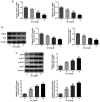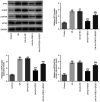FGF21 attenuates high uric acid‑induced endoplasmic reticulum stress, inflammation and vascular endothelial cell dysfunction by activating Sirt1
- PMID: 34850960
- PMCID: PMC8669652
- DOI: 10.3892/mmr.2021.12551
FGF21 attenuates high uric acid‑induced endoplasmic reticulum stress, inflammation and vascular endothelial cell dysfunction by activating Sirt1
Abstract
Uric acid (UA) is the final oxidation product of purine metabolism. Hyperuricemia has been previously reported to contribute to vascular endothelial dysfunction and the development of cardiovascular diseases, metabolic syndrome and chronic kidney diseases. In addition, it has been reported that fibroblast growth factor 21 (FGF21) can exert regulatory effects on UA‑induced lipid accumulation. Therefore, the present study aimed to investigate the possible role of FGF21 in HUVEC cell injury induced by UA. The study used UA to induce HUVEC cell injury, inhibited sirtuin 1 (Sirt1) expression using EX527 and overexpressed FGF21 by transfection. Subsequently, reverse transcription‑quantitative PCR was performed to measure the mRNA expression levels of FGF21, Sirt1 and inflammatory cytokines TNF‑α, IL‑1β and IL‑6, whereas western blotting was performed to measure their corresponding protein expression levels including FGF21, Sirt1, NLR family pyrin domain containing 3, pro‑caspase1, apoptosis‑associated speck‑like protein containing a CARD, activating transcription factor 4, C/EBP homologous protein and eukaryotic initiation factor 2. Furthermore, dichloro‑dihydro‑fluorescein diacetate staining was performed to measure intracellular reactive oxygen species (ROS) generation in HUVECs. The levels of ROS and nitric oxide were also quantified using commercial assay kits. The results demonstrated that overexpression of FGF21 significantly inhibited UA treatment‑induced endoplasmic reticulum (ER) stress, inflammation and oxidative stress in HUVECs. Furthermore, overexpression of FGF21 significantly activated Sirt1. The sirt1 inhibitor, EX527, significantly abrogated the suppressive effects of FGF21 overexpression on ER stress, inflammation and oxidative stress in UA‑stimulated HUVECs. To conclude, results of the present study suggested that FGF21 may attenuate UA‑induced ER stress, inflammation and vascular endothelial cell dysfunction by activating Sirt1. Therefore, FGF21 may be a potential effective target for the future treatment of vascular endothelial cell dysfunction.
Keywords: fibroblast growth factor 21; hyperuricemia; sirtuin 1; uric acid.
Conflict of interest statement
The authors declare that they have no competing interests.
Figures






References
-
- Stodle GS, Silva GB, Tangeras LH, Gierman LM, Nervik I, Dahlberg UE, Sun C, Aune MH, Thomsen LCV, Bjørge L, Iversen AC. Placental inflammation in pre-eclampsia by Nod-like receptor protein (NLRP)3 inflammasome activation in trophoblasts. Clin Exp Immunol. 2018;193:84–94. doi: 10.1111/cei.13130. - DOI - PMC - PubMed

